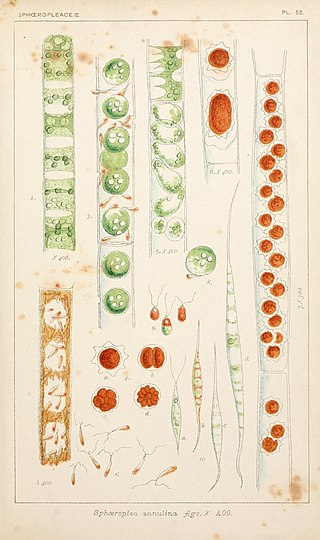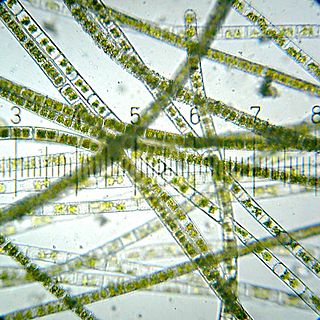
The Chlorophyceae are one of the classes of green algae, distinguished mainly on the basis of ultrastructural morphology. They are usually green due to the dominance of pigments chlorophyll a and chlorophyll b. The chloroplast may be discoid, plate-like, reticulate, cup-shaped, spiral- or ribbon-shaped in different species. Most of the members have one or more storage bodies called pyrenoids located in the chloroplast. Pyrenoids contain protein besides starch. Some green algae may store food in the form of oil droplets. They usually have a cell wall made up of an inner layer of cellulose and outer layer of pectose.

Chlamydomonas is a genus of green algae consisting of about 150 species of unicellular flagellates, found in stagnant water and on damp soil, in freshwater, seawater, and even in snow as "snow algae". Chlamydomonas is used as a model organism for molecular biology, especially studies of flagellar motility and chloroplast dynamics, biogenesis, and genetics. One of the many striking features of Chlamydomonas is that it contains ion channels (channelrhodopsins) that are directly activated by light. Some regulatory systems of Chlamydomonas are more complex than their homologs in Gymnosperms, with evolutionarily related regulatory proteins being larger and containing additional domains.

The green algae are a group of chlorophyll-containing autotrophic eukaryotes consisting of the phylum Prasinodermophyta and its unnamed sister group that contains the Chlorophyta and Charophyta/Streptophyta. The land plants (Embryophytes) have emerged deep in the Charophyte alga as a sister of the Zygnematophyceae. Since the realization that the Embryophytes emerged within the green algae, some authors are starting to include them. The completed clade that includes both green algae and embryophytes is monophyletic and is referred to as the clade Viridiplantae and as the kingdom Plantae. The green algae include unicellular and colonial flagellates, most with two flagella per cell, as well as various colonial, coccoid and filamentous forms, and macroscopic, multicellular seaweeds. There are about 22,000 species of green algae, many of which live most of their lives as single cells, while other species form coenobia (colonies), long filaments, or highly differentiated macroscopic seaweeds.

Charophyta is a group of freshwater green algae, called charophytes, sometimes treated as a division, yet also as a superdivision or an unranked clade. The terrestrial plants, the Embryophyta emerged deep within Charophyta, possibly from terrestrial unicellular charophytes, with the class Zygnematophyceae as a sister group.

The Zygnemataceae are a family of filamentous or unicellular, uniseriate (unbranched) green algae. The filaments are septated and reproduction is by conjugation; Spirogyra is commonly used in schools to demonstrate this kind of reproduction. The family is notable for its diversely shaped chloroplasts, such as stellate in Zygnema, helical in Spirogyra, and flat in Mougeotia. The Zygnemataceae are cosmopolitan, but though all generally occur in the same types of habitats, Mougeotia, Spirogyra, and Zygnema are by far the most common; in one study across North America, 95% of the Zygnemataceae collected were in these three genera. Classification and identification is primarily by the morphology of the conjugation, which is somewhat rare to find in natural populations of permanent water bodies; when in the vegetative state, the rarer genera resemble the three most common, and are often mistaken for them and catalogued as such. Conjugation can be induced in low-nitrogen culture. While they occupy many habitats, in North America all are found solely in freshwater or subaerial habitats. Species typically exist as floating mats in stagnant water in ditches and ponds, but some also grow in moving water, attaching themselves to a substrate by rhizoid-like projections of the basal cells of the filament. The mat species rise to the surface in early spring, grow rapidly through the summer, disappearing by late summer. Members of the Zygnemataceae, such as Spirogyra, fall prey to parasites, especially chytrids. Most genera previously assigned to Mesotaeniaceae as well as the Desmidiales actually emerged in the Zygnematacae.

Ulothrix is a genus of green algae in the family Ulotrichaceae.
Chaetosphaeridium globosum is a one-celled alga which is thought to represent an ancient lineage of the green plants. This organism exists in a filamentous form with one flagella per cell. It is a freshwater species. The flagellum is covered in scales in a 3-prong irregular shape called ‘maple leafs’. The cells are usually 11–18 micrometres (0.00043–0.00071 in) in diameter and with one pyrenoid. Each cell bears long bristle.

Selenastraceae is a family of green algae in the order Sphaeropleales. Members of this family are common components of the phytoplankton in freshwater habitats worldwide. A few species have been found in brackish and marine habitats, such as in the Baltic Sea.

Botryococcus is a genus of green algae. The cells form an irregularly shaped aggregate. Thin filaments connect the cells. The cell body is ovoid, 6 to 10 μm long, and 3 to 6 μm wide. Fossils of the genus are known since Precambrian times, and form the single largest biological contributor to crude oil, and are a major component of oil shales.

Bryopsis is a genus of marine green algae in the family Bryopsidaceae. It is frequently a pest in aquariums, where it is commonly referred to as hair algae.

Cylindrocapsa is a genus of green algae, specifically of the Chlorophyceae. It is commonly found in freshwater habitats.
Lobocharacium is a genus of green algae in the family Characiosiphonaceae. It contains the single species Lobocharacium coloradoense. It has been isolated from a pond in Colorado, United States.

Sphaeroplea is a genus of green algae in the family Sphaeropleaceae. It was first circumscribed by the Swedish botanist Carl Adolph Agardh in 1824.

The genus Umbraulva, which is a green alga within the Ulvaceae family, was proposed by Bae and Lee in 2001. Three additional species, including U. kuaweuweu, which was subsequently transferred to another genus, have been added to the genus since it originally had the three species that were initially examined to form the genus. Umbraulva species grow upon hard substrates, and inhabit deep subtidal areas. Species within this genus are widely distributed, and have been identified in Asia, Europe, Hawaii, and New Zealand. The morphological traits of Umbraulva vary among species, but commonly, Umbraulva are macroscopic with olive green blades containing the photosynthetic pigment siphonaxanthin. The blades are flattened and ellipsoid in shape, or are narrow and oval shaped, with perforations and/or lobes present throughout the blade. As Umbraulva often appear very similar in morphology to closely related groups, the main manner in which Umbraulva was differentiated from related groups was through the divergence of ITS and partial SSU rDNA sequences from those of other Ulva species. Umbraulva is closely related to Ulva, which due to wide distributions, high carbohydrate levels, and a lack of lignin, is a good candidate for use in biofuel, bioremediation, carbon sequestration, and animal feed production.

The Klebsormidiaceae are a family containing five genera of charophyte green alga forming multicellular, non-branching filaments. The genus Chlorokybus was previously included as well, but this problematic and poorly known genus is now placed in a separate class Chlorokybophyceae.

Red algae, or Rhodophyta, are one of the oldest groups of eukaryotic algae. The Rhodophyta comprises one of the largest phyla of algae, containing over 7,000 currently recognized species with taxonomic revisions ongoing. The majority of species (6,793) are found in the Florideophyceae (class), and mostly consist of multicellular, marine algae, including many notable seaweeds. Red algae are abundant in marine habitats but relatively rare in freshwaters. Approximately 5% of red algae species occur in freshwater environments, with greater concentrations found in warmer areas. Except for two coastal cave dwelling species in the asexual class Cyanidiophyceae, there are no terrestrial species, which may be due to an evolutionary bottleneck in which the last common ancestor lost about 25% of its core genes and much of its evolutionary plasticity.

Choristocarpaceae is a family in the order Discosporangiales of the brown algae. The family contains a single genus, Choristocarpus. The species is mostly located in the cold waters of the Northern hemisphere. A type of seaweed, Choristocarpaceae attaches itself to rocky substrate in places that are near continental shelves and the shore. Due to the species having morphological similarity, they were classified in closer relation with D. mesarthrocarpum. But due to many other differing characteristics Choristocarpaceae were put into their own family with a single genus and a single species of brown algae.

Vaucheria litorea is a species of yellow-green algae (Xanthophyceae). It grows in a filamentous fashion. V. litorea is a common intertidal species of coastal brackish waters and salt marshes of the Northern Atlantic, along the coasts of Europe, North America and New Zealand. It is also found in the Eastern Pacific coasts of Washington state. It is found to be able to tolerate a large range of salinities, making it euryhaline.

Phacus is a genus of unicellular excavates, of the phylum Euglenozoa, characterized by its flat, leaf-shaped structure, and rigid cytoskeleton known as a pellicle. These eukaryotes are mostly green in colour, and have a single flagellum that extends the length of their body. They are morphologically very flat, rigid, leaf-shaped, and contain many small discoid chloroplasts.

Zygnema is a genus of freshwater filamentous thalloid alga comprising about 100 species. A terrestrial species, Z. terrestre, is known from India. Zygnema grows as a free-floating mass of filaments, although young plants may be found anchored to streambeds with a holdfast. The filaments form a yellow-green to bright green colored tangled mat, and are composed of elongate barrel-shaped cells, each with two star-shaped (stellate) chloroplasts arrayed along the axis of the cell.



















